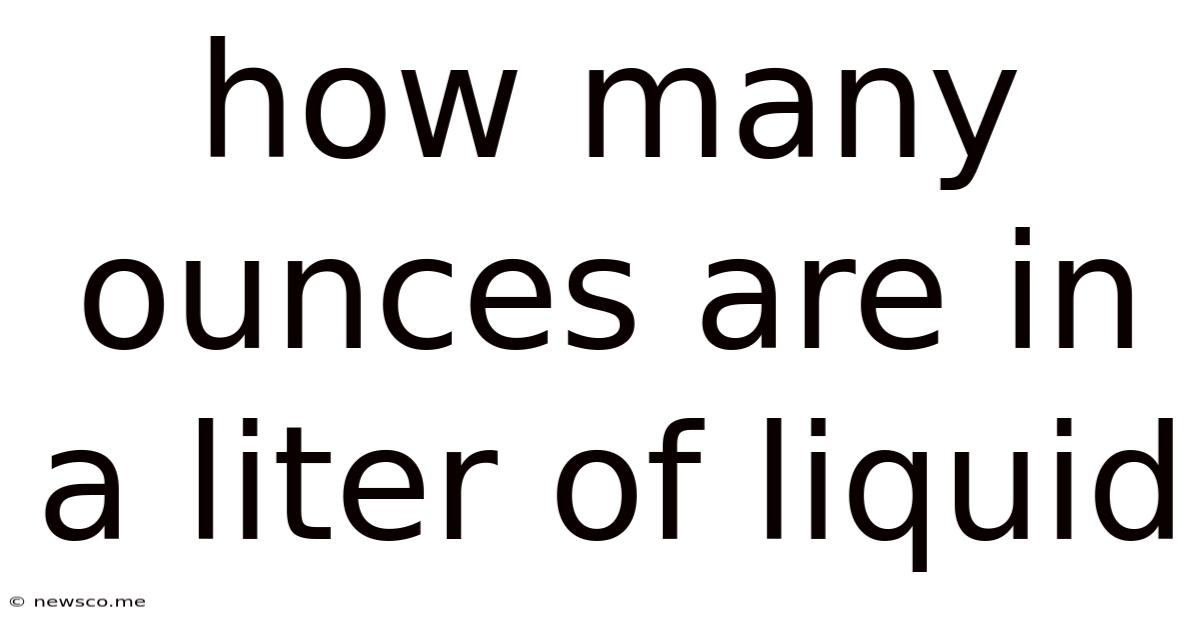How Many Ounces Are In A Liter Of Liquid
News Co
May 07, 2025 · 4 min read

Table of Contents
How Many Ounces Are in a Liter of Liquid? A Comprehensive Guide
Understanding unit conversions is crucial in various aspects of life, from cooking and baking to scientific research and international trade. One common conversion that often causes confusion is determining how many ounces are in a liter of liquid. This comprehensive guide will delve deep into this conversion, exploring the nuances, providing precise calculations, and offering practical examples to solidify your understanding.
Understanding Units of Measurement: Ounces and Liters
Before jumping into the conversion, let's establish a clear understanding of the units involved: ounces and liters.
Ounces (oz)
The ounce (oz) is a unit of volume and weight. When discussing liquids, we primarily refer to fluid ounces (fl oz). The fluid ounce is a unit of volume in the US customary units and the imperial units systems. It's important to differentiate it from the avoirdupois ounce, which is a unit of mass or weight. The difference is significant and often leads to errors in conversions.
Liters (L)
The liter (L) is a metric unit of volume. The metric system is based on powers of 10, making conversions within the system relatively straightforward. A liter is a widely used unit internationally, especially in scientific contexts and many countries' everyday life.
The Conversion: Ounces to Liters and Vice Versa
The precise conversion factor between fluid ounces and liters is 1 liter = 33.814 fluid ounces. This means that one liter of liquid contains approximately 33.814 fluid ounces.
Conversely, 1 fluid ounce is approximately equal to 0.02957 liters.
Why is the Conversion Not a Whole Number?
The seemingly awkward decimal in the conversion factor is a consequence of the distinct origins and definitions of the two systems. The US customary system and the imperial system, which both use fluid ounces, have evolved independently from the metric system, which utilizes liters. Therefore, their units aren't directly related by simple whole number ratios.
Practical Applications and Examples
Let's illustrate the conversion with several practical examples:
Example 1: Converting Liters to Fluid Ounces
You have a 2-liter bottle of soda. How many fluid ounces does it contain?
- Calculation: 2 liters * 33.814 fl oz/liter = 67.628 fl oz
Therefore, a 2-liter bottle of soda contains approximately 67.63 fluid ounces.
Example 2: Converting Fluid Ounces to Liters
A recipe calls for 16 fluid ounces of milk. How many liters is that?
- Calculation: 16 fl oz * 0.02957 L/fl oz = 0.47312 L
Therefore, 16 fluid ounces of milk is approximately 0.47 liters.
Example 3: Real-world application: comparing liquid packaging
Imagine you're comparing two different juice bottles at the supermarket: one is labeled as 1 liter, and the other as 32 fluid ounces. Which one contains more juice?
- Conversion: 32 fl oz * 0.02957 L/fl oz ≈ 0.946 liters
The 1-liter bottle contains more juice than the 32-fluid ounce bottle. This simple conversion can help you make informed purchasing decisions.
Factors Affecting Accuracy
While the conversion factor of 33.814 fl oz per liter is generally accurate, several factors can slightly affect the precision of the conversion in real-world scenarios:
- Temperature: Liquid volumes can change slightly with temperature fluctuations. This is especially relevant for liquids with higher thermal expansion coefficients.
- Measurement Precision: The accuracy of the conversion depends on the precision of the measuring instruments used. Inaccurate measuring devices can introduce errors into the final result.
- Liquid Properties: The behavior of certain liquids may vary due to their viscosity, surface tension, and other properties.
These factors can introduce minor discrepancies in the conversion, but for most practical purposes, the standard conversion factor provides sufficient accuracy.
Beyond the Basic Conversion: Exploring Related Units
Understanding the ounces-to-liters conversion opens the door to working with other related units of volume, including:
- Gallons (gal): One US gallon equals 128 fluid ounces. This allows you to convert liters to gallons and vice-versa using a two-step conversion process (liters to ounces, then ounces to gallons).
- Milliliters (mL): One liter is equal to 1000 milliliters. This is a simple conversion within the metric system.
- Cubic centimeters (cc or cm³): One milliliter is equivalent to one cubic centimeter. This connection highlights the three-dimensional nature of volume measurements.
Mastering the conversion between ounces and liters provides a strong foundation for understanding and working with a broader range of volume units.
Tips for Accurate Conversions
To ensure accurate conversions, consider the following tips:
- Use a Calculator: A calculator will help avoid manual calculation errors, especially with decimal numbers.
- Round Appropriately: Round your results to a reasonable number of decimal places, depending on the required level of precision. For most everyday purposes, rounding to two decimal places is sufficient.
- Double-Check Your Work: Always review your calculations to avoid mistakes.
- Understand the Units: Always clarify whether you're working with fluid ounces or avoirdupois ounces to avoid confusion.
Conclusion
The conversion between ounces and liters is a fundamental skill in various fields. Understanding the conversion factor, its implications, and potential sources of minor inaccuracies allows you to confidently navigate different measurement systems and make informed decisions in various contexts, from cooking and baking to scientific experiments and international business transactions. Remember to use the appropriate conversion factor (1 liter = 33.814 fluid ounces) and be mindful of potential factors influencing the accuracy of your conversion.
Latest Posts
Related Post
Thank you for visiting our website which covers about How Many Ounces Are In A Liter Of Liquid . We hope the information provided has been useful to you. Feel free to contact us if you have any questions or need further assistance. See you next time and don't miss to bookmark.